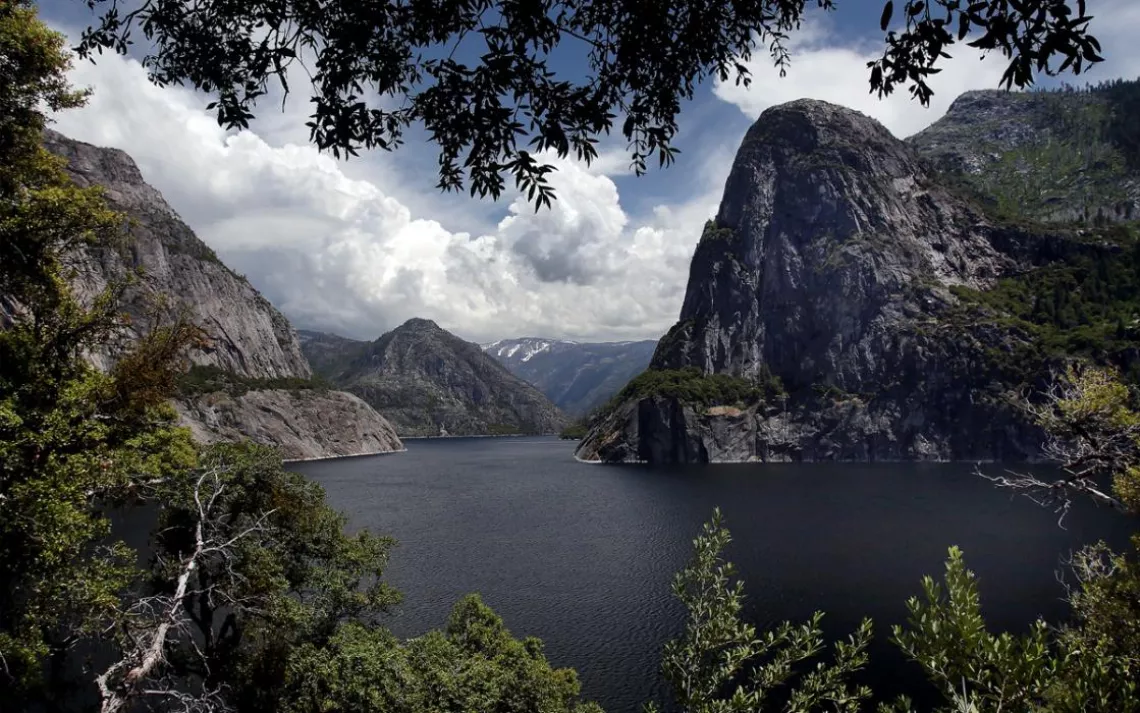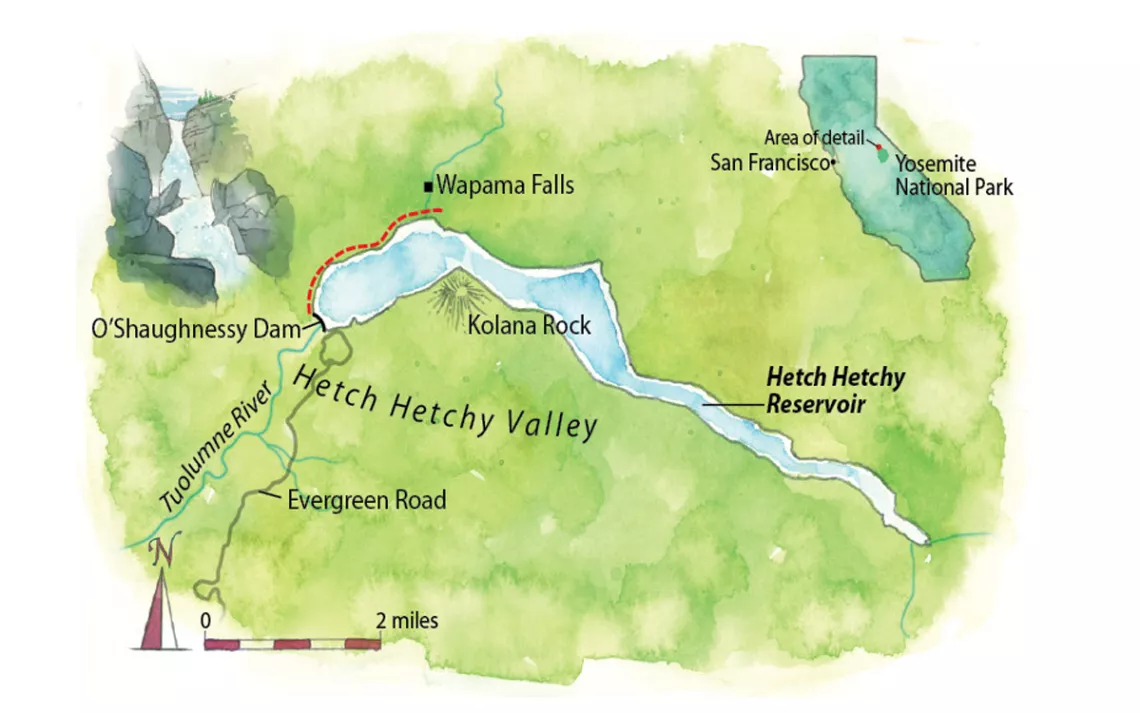Yosemite's Accidental Wilderness
Hetchy Hetchy Valley is a stain on the map of American environmentalism—and an oasis of solitude

Photo by Dino Vournas
The previous winter had been a season full of storms that dumped copious amounts of snow on the Sierra Nevada, and I heard that the waterfalls were roaring. So my 10-year-old son and I decided to make an impromptu June trip to the mountains to see the spectacle for ourselves. Our destination: Wapama Falls, a thousand-foot cascade that John Muir once described as "roaring and thundering, pounding its way with the weight and energy of an avalanche."
Muir's description was spot-on. A mile from Wapama Falls, we could hear its thunderous bass, as if the very rock overhead was being torn asunder. Before we'd started the 2.5-mile hike along the Hetch Hetchy Trail, a ranger had told us to be careful. "There's lots of water in the streams," she said, gesturing to a poster of a hiker who had been swept away while crossing the Wapama footbridge days earlier. "We're still looking for him."
An hour into the hike, we crested a ridge and were hit with a heavy mist from the falling water. We donned rain jackets and pressed on. When we reached the footbridge, we were confronted with churning pinwheels of foam. The Wapama was a white torrent, smashing against the wooden bridge, which was hitched to the cliff below, with deadly force. Several steel support cables had come unmoored and were snapping to and fro.
Water streamed from the brim of my son's ball cap as he surveyed the scene. "We're not going to try to cross that, are we?" he asked, smiling wildly, teeth chattering.
"Not today," I replied. "Next time."
I expect that next time will be soon, because I've come to believe that Hetch Hetchy Valley is among the underappreciated gems of Yosemite National Park. In more than a decade as an environmental writer, I've become a tourist of ecological carnage. I've wandered amid the hydrogen sulfide stench of oilfields and circumnavigated the calderas of pit mines. But until I visited Hetch Hetchy, I'd never seen a landscape desecration that elicited such feelings of ambivalence. On the one hand, Hetch Hetchy Reservoir is an incontrovertible stain on the map of American environmentalism. On the other, the drowned valley has become an oasis of solitude in a national park that, in many places, has come to resemble a shopping mall parking lot more than a nature reserve.
Those two words, Hetch Hetchy—which come from a Miwok word that translates roughly to "edible grasses"—have become a sort of shorthand for ecological destruction. San Francisco leaders used the 1906 earthquake and subsequent fire that destroyed the city as political leverage for a water-diversion project that they had been unsuccessfully trying to get built for years. The object of their desire was a valley teeming with waterfalls and rushing streams. In its depths grew tall pines and thigh-high grasses among which the Tuolumne River meandered. In the eyes of the dam builders, the valley was a massive water-storage basin, eight miles long and in some places as much as 2,000 feet deep.
In 1908, as surveyors staked out the valley, Sierra Club founder John Muir wrote, "Dam Hetch Hetchy! As well dam for water-tanks the people's cathedrals and churches, for no holier temple has ever been consecrated by the heart of man."
And yet, for all the force of his rhetoric, Muir could not stop the reservoir; in 1923, O'Shaughnessy Dam was completed.
There's no doubt that a bathtub of impounded water is not, in any true sense of the word, wild. Yet more than a century after the valley's damnation, Hetch Hetchy and its surroundings have become an unlikely sanctuary, an accidental wilderness that is free of the commercialization and overcrowding that today's visitors encounter throughout so many national parks.

Map by Steve Stankiewicz
Walking in the calm of Hetch Hetchy, it's easy to see why early-20th-century conservationists wanted to protect it from the dam. Even drowned, the glacier-carved valley is stunning. Here, days pass slowly, measured by the clockwork wheeling of golden eagles overhead and the blooming of wildflowers from granite fissures underfoot. No car engine sounds reverberate from the canyon's fortresslike walls. Nor are boats allowed on the reservoir, leaving its surface unbroken by any wake. The mirrorlike reflection of the cone-shaped Kolana Rock—little brother to Yosemite Valley's Cathedral Rocks—gives an illusion of the canyon's former depth.
During the recent hike with my son, one of the few sounds we heard, apart from the roar of the falls, was the glissando call of a lone canyon wren echoing from the cliffs. This corner of the park is a welcome respite from the clamor and clatter of Yosemite Valley. While Hetch Hetchy suffered the fate of being submerged, the wildlands above the waterline have been spared being flooded by people.
It is, of course, possible to love a place without acceding to the forces that created it. O'Shaughnessy Dam should be torn down; Hetch Hetchy should be restored to the valley paradise it was for millennia. And in the course of that ecological restoration, we might also rethink our ideas about wildlands recreation, and strike a better balance between public access and private solitude. In the process, we might end up creating a wilderness by design.
This article appeared in the September/October 2019 edition with the headline "An Accidental Wilderness."
WHERE Hetch Hetchy Valley, Yosemite National Park, California
GETTING THERE From the San Francisco Bay Area, head east on California State Route 120 for 150 miles. Less than one mile from the Yosemite National Park entrance, turn left on Evergreen Road. From there, it's a 40-minute drive to the Hetch Hetchy Trail, which starts at O'Shaughnessy Dam.
WHEN TO VISIT The waterfalls are at their best in spring. Fall is the season for solitude. Summers can be brutally hot, while heavy winter storms can close the narrow access road to the dam. If you are day hiking, be sure to get back to the parking lot before the gate is locked at sundown.
PERMITS None are required for day hikes in the front country. Free, quota-based permits are required for overnight stays in the surrounding backcountry.
MUST-SEE The moderate, 2.5-mile trail to Wapama Falls provides stunning views as it wends along a ledge above the reservoir. Backpackers with days to spare can make the 29-mile-loop trip to Laurel Lake and Lake Vernon.
GETTING ABOVE IT ALL The 12-mile round-trip hike to the 7,750-foot summit of Smith Peak will get your lungs pumping. It also provides stunning views of the Hetch Hetchy Valley and the high country of Yosemite beyond.
SURVIVAL TIP Bring good raingear. If water is cascading over the wooden bridge at the base of Wapama Falls, proceed with extreme caution.
REQUIRED READING Check out the chapter "Hetch Hetchy Valley" in John Muir's book The Yosemite, which provides a vivid depiction of the valley before the construction of O'Shaughnessy Dam.
Take a Sierra Club trip to Yosemite. For details, see sc.org/adventure-travel.
 The Magazine of The Sierra Club
The Magazine of The Sierra Club



